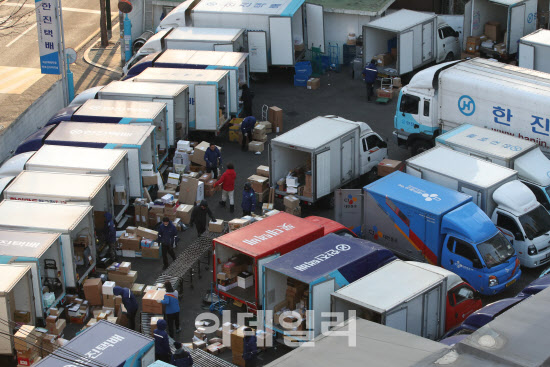In the industry, social consensus is formed now is the right time for structural change.
|
According to the industry on the 3rd, major couriers plan to complete the input of sorting labor by the 4th. CJ Logistics has 4,000, while Hanjin and Lotte have 1,000. This is an evaluation that is the touchstone of structural changes in the parcel delivery industry.
The courier industry has been serving for about 30 years since 1992. However, there was no legal safety net.
The growth of e-commerce and the social issue of Corona 19 sparked the growth of the parcel delivery industry, but excessive labor was passed on to the parcel worker, leading to overwork.
Last year, when the problem of rights and interests of courier workers became a hot topic, a bill related to the parcel delivery industry (the Living Logistics Service Development Act) was first created. A social consensus organization with which the government participates has also been launched to address the problem.
It was triggered by an unfortunate event, but as an opportunity for the change in the delivery structure was prepared, a suggestion is made that we need to look back on areas that we have not been able to look at.
First of all, it is a problem of raising the delivery cost. It has been declining for many years and has reached its limit, and it is intended to be used for system supplementation such as preservation of the import of courier drivers and automation of logistics tasks due to restrictions on late-night delivery.
|
It should also be accompanied by an improvement in the perception of customers who think that’the courier fee is up to 2,500 won’. The so-called’back margin’ transaction practice, in which shopping malls receive part of the parcel delivery fee, is also controversial.
However, some advise that you should be wary of being greedy to solve problems accumulated over a long period of time. This is because if the structural part of the industry is overlooked by focusing only on the external part, unexpected results can occur.
For example, if we simply restrict late-night delivery to prevent overwork of courier drivers, it could lead to division and increase in areas of courier drivers to handle the increasing volume. If the guarantee of rest rights is a result of the split of income, the delivery driver may be dissatisfied.
Dr. Park Chan-ik of the Hanjin Logistics Research Institute said, “It is important to understand the mechanism of the parcel delivery industry and to find a solution suitable for Korean-style parcel delivery rather than come up with a solution overnight.”


